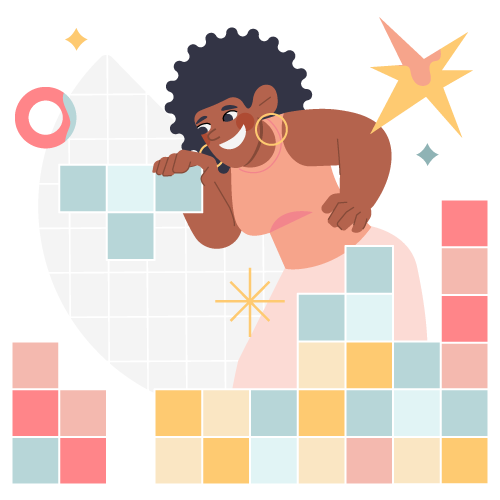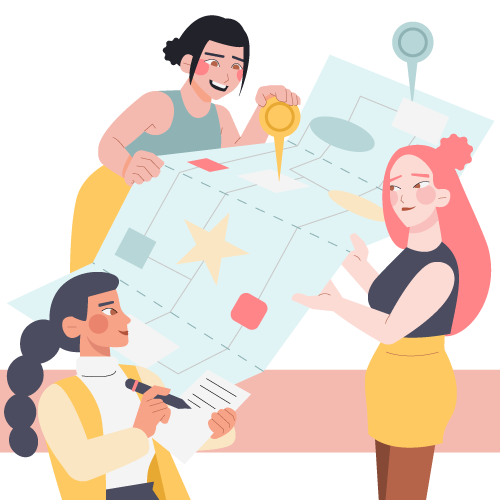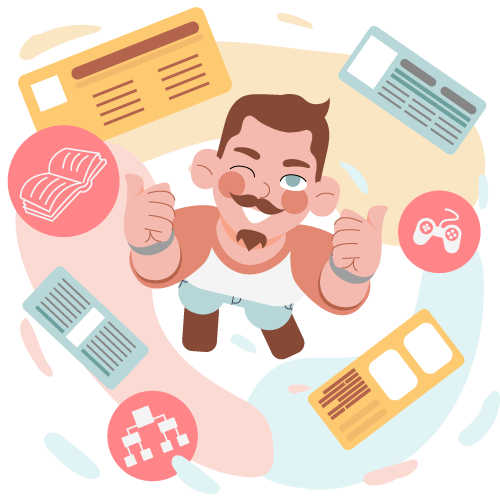In the eyes of cognitivists, effective learners don’t cram information. They don’t push information into their brains in the hopes it sticks. Instead, effective learners focus on understanding topics.
That’s how they learn more and better. But most importantly, that’s how they apply knowledge more effectively.
Engaging your senses and reasoning are essential for competence development, critical thinking, problem-solving, and high performance on the job.
So, in this blog, we list and explain 15 cognitive learning examples, and we talk about the benefits of cognitive learning and where you can apply it, whether you’re an educator, learning experience designer, corporate trainer, or just a curious lifelong learner.
What is cognitive learning?
Cognitive learning is a theory that explains learning based on how the human brain works.
It builds on the capability of our brain to absorb information through senses and retain knowledge through reasoning—a process called “cognition.”
For cognitivists, the way we think influences the way we learn, so if we train our brains to think more effectively, we’ll end up learning more effectively. This means understanding topics rather than cramming them.
As a result, we become better at connecting new and existing information in our heads, and we recall new concepts for a longer time. Without that, we wouldn’t be able to apply knowledge effectively, think critically, solve problems, or be autonomous within our roles at work.
Cognitivists claim that cognition brings a deeper understanding of learned topics and better leadership development. From their perspective, employees who think better become better team members and better leaders, with vision and motivation to help companies achieve their goals.
Just so you know, standing on the opposite side of cognitive learning is behavioral learning, which explains learning based on how we interact with the environment around us. Behaviorists consider that we absorb information and build knowledge by associating behaviors with either positive or negative outcomes.
Comprehensive list of cognitive learning examples
According to cognitive learning theory, there’s a flavor of learning for every brain. So, we put together a list for you with 15 cognitive learning examples you can apply in either educational or corporate settings, and even for personal development.
- Implicit learning. This is a kind of learning that requires no conscious effort or intention. For instance, when you pick up social cues or decipher sarcasm because you’ve been repeatedly involved in social interactions, that’s a sign you’ve learned something implicitly. And in the daily interaction between team members, they learn about tone and timing without even noticing or reading training manuals.
- Explicit learning. Instead of learning without a conscious effort or intention, explicit learning requires a structure and a more focused goal, such as passing an exam or being able to speak a new language. When you learn explicitly, you read training resources, just like new hires do when they learn company policies, safety protocols, or enroll in compliance training.
- Meaningful learning. The meaning in this type of learning comes from connecting new information to what you already know by associating the new concepts with your feelings and personal interests. That’s a strategy widely used by teachers and instructors who use analogies to explain new things. For instance, science teachers sometimes explain what electrical circuits are by comparing them with the way water flows.
- Cooperative learning. This is a form of group learning. It consists of having students or team members working in groups and collaborating with each other to achieve a common goal. For instance, in brainstorming sessions in the workplace, team members use divergent thinking techniques to generate ideas and solve problems together (on top of growing the team’s cohesion).
- Discovery learning. In this type of learning, the teacher or instructor encourages learners to discover new concepts independently by exploring solutions and drawing conclusions on their own. It’s a hands-on kind of learning, heavily based on human curiosity and a willingness to explore. Managers, for example, may challenge new hires to solve hypothetical problems with company tools without a procedure to follow. Science experiments in the classroom are another example.
- Experiential learning. This is when you learn by doing, from experience, not from theory alone. Internships, rotations, and shadowing are classical examples of experiential learning on the job.
- Emotional learning. Rather than learning in a specific way, this is about learning a certain topic—dealing with emotions. That involves learning to read the room, self-regulate, empathize with others, and communicate effectively. Companies, for instance, deliver emotional intelligence training and interpersonal communication courses to employees to help them identify emotional triggers and respond constructively.
- Problem-based learning. Students or employees work in groups to solve hypothetical, open-ended problems based on real-world issues. The teacher or instructor doesn’t teach classes before assigning problems. Instead, the learning process starts when they assign problems to learners. Then, learners search for the information they need to solve the problems, analyze it, and come up with optimal solutions (often by innovating). In business, when cross-functional teams address customer pain points by applying design thinking, they’re involved in problem-based learning.
- Game-based learning. In this type of learning, whether in school or at companies, games are used to learn new concepts in a fun, engaging way. The learning content, activities, and assessments are incorporated into the game, which can be digital or not. Learners play the games individually or in teams, and the games can be quest-based or resemble Jeopardy, to name a couple of possibilities.
- Habituation and sensitization. This involves learning through repeated exposure to stimuli to either reduce or increase the learners’ response to those stimuli. In other words, the goal is either to habituate learners to the stimuli, so they don’t react to it, or to sensitize them to the stimuli, so they act on it. For example, safety drills are meant to habituate employees to react calmly under pressure.
- Metacognitive strategies. Thinking about how you think, what you learned, and how you learned is not only a skill in itself, but it also helps you learn better. Journaling, for instance, is a metacognitive strategy you can use to assess your knowledge, plan further learning, identify improvements, and track growth (in your personal and professional lives). It’s also great for leadership development.
- Concept mapping. Using visual tools or just a pen and a piece of paper, you can break down complex concepts into smaller ones that you represent hierarchically and connect with each other (for better understanding). For example, marketing teams create customer journey maps to visually represent the journey stages and what happens at each one of those stages.
- Scenario-based learning. With online, automated dialogue simulations, learners practice decision-making in hypothetical situations and controlled environments where they can’t lose deals, make customers angry, or damage workplace relationships. That’s the case when HR professionals engage in role-playing exercises to learn to handle difficult conversations or ethical dilemmas. And it’s also the case when sales reps practice pitching skills during sales training.
- Self-directed learning. This is what happens when highly motivated employees study topics independently, usually beyond office hours. That’s self-directed learning, and the purpose is career development. They’re self-starters and take the initiative to outline their own learning goals and evaluate progress. Self-taught professionals or anyone learning a new hobby, for instance, can also direct their own learning process.
- Collaborative learning. Whenever a pair of coworkers or a small team work together to solve problems, share perspectives, and discuss topics, collaborative learning takes place. For example, scrum retrospectives are collaborative learning moments during which agile teams learn to improve their processes. Pair programming is another way to learn collaboratively, in this case, learning computer programming with a teammate.
Benefits of using cognitive learning examples
Putting into practice any of the cognitive learning examples we just gave you will help you follow the cognitive learning theory and reap its benefits.
Greater information retention
Engaging in an active style of learning and understanding concepts, more than just memorizing them, improves learning retention. And the more you apply the cognitive learning examples in this article, the more and the better you’ll retain what you learn.
Critical thinking development
Understanding topics rather than cramming loads of information without retaining it for too long builds your analytical skills. And that’s why you need to think critically, solve problems more effectively, innovate, and make better decisions at work and in your personal life.
Besides, developing critical thinking through cognitive learning enables you to apply the lessons you learn in one context to another—and do it confidently.
Real-world relevance
A deeper understanding of information makes it much easier to apply the information to your work and your life and to trust that you can do that, which is already motivating.
But on top of comprehension, being able to actually apply learned concepts in the real world is not only exciting but also a reason behind effective problem-solving.
Love of learning
Cognitive learning grows lifelong learners who enjoy learning and can more easily adapt to change. They’re always eager to learn something new and are used to the learning process overall.
Lifelong learners recall what they’ve learned in the past, connect it with what they’re learning in the present, and apply all that so they’re always evolving, becoming better students, better employees, and better people.
Applications of cognitive learning examples in context
The cognitive learning examples we compiled change the way people learn and grow in their personal and professional lives. The examples all apply to more than one context, whether that’s an industry, an age group, or a learning environment, but let’s recap the three contexts we touched on in this article.
Education
Discovery learning is widely used by STEM teachers, who ask their students to run experiments and explore solutions as a way to discover new concepts independently. But any student can apply cognitive learning techniques, such as drawing concept maps to organize ideas before writing essays. Student teams can also group up to discuss assignments in a cooperative learning style.
Corporate training
At companies, scenario-based learning challenges current and aspiring leaders in training with real-world situations they must handle in risk-free environments, allowing them to safely practice tough conversation management. Game-based learning—a form of edutainment that’s not the same as gamification—makes sales training and compliance training more exciting, engaging, and effective. And metacognitive strategies, such as journaling, are excellent during new hire training to encourage self-assessment since day one.
Personal growth
Self-directed learning allows everyone to learn a new hobby or a new skill independently. Emotional learning teaches you to be more aware of yourself and others, self-regulate, empathize, and communicate more effectively. And experiential learning through volunteer work develops skills you couldn’t learn from books (or at least learn as well as you can by doing).
Start applying cognitive learning today
Cognitive learning examples are instruments to learn more, learn better, and grow as a student, a professional, and a person.
Whether you’re designing a curriculum at school, revamping a corporate training program, or just looking to improve your own learning methods, the 15 examples in this article will get you there.
Need help with the implementation part at your company? Reach out to us to learn about how our solutions can serve that purpose.






